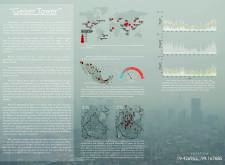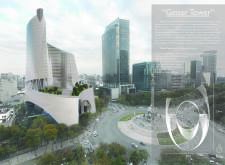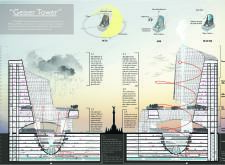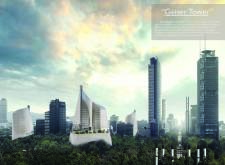5 key facts about this project
The core function of the Geiser Tower is to purify the surrounding air while also managing rainwater through an advanced collection system. By utilizing natural processes, the building serves both as a residential and commercial space, promoting community interaction within an urban context. Its design incorporates features that enable it to actively contribute to environmental health, presenting a forward-thinking approach to urban living.
Unique Environmental Integration
What differentiates the Geiser Tower from typical urban structures is its dual functionality—simultaneously acting as an air-purifying unit and a water collection mechanism. The building's architecture includes integrated green roofs and terraces that enhance biodiversity, while also providing recreational space. This design fosters a connection between ecology and urban life, promoting an active lifestyle within a green environment.
The structure features a sculptural silhouette that allows for effective airflow, enhancing its ability to filter pollutants. The incorporation of photovoltaic solar panels into the canopy not only bolsters the building’s energy efficiency but also aligns with its eco-friendly ethos. These elements work harmoniously, allowing the tower to exemplify sustainability in action.
Advanced Material Utilization
The Geiser Tower utilizes high-performance concrete, glass panels, and a steel framework, which provide structural integrity and aesthetic appeal. High-performance concrete allows for advanced structural solutions while reducing the carbon footprint of the construction process. The glass façade maximizes natural light, further reducing energy consumption, while the steel framework offers flexibility for spatial organization within the tower.
Incorporating green roofing systems enhances thermal insulation and contributes to stormwater management. These material choices reinforce the project's commitment to sustainable architecture, ensuring that the Geiser Tower stands resilient against the challenges posed by urbanization.
To explore the intricate architectural plans, sections, and designs of the Geiser Tower, readers are encouraged to delve deeper into the project presentation, which offers detailed insights into the architectural ideas and innovations that underpin this significant addition to urban architecture. This exploration can provide invaluable perspectives for those interested in sustainable design practices and their implementation in real-world scenarios.


























